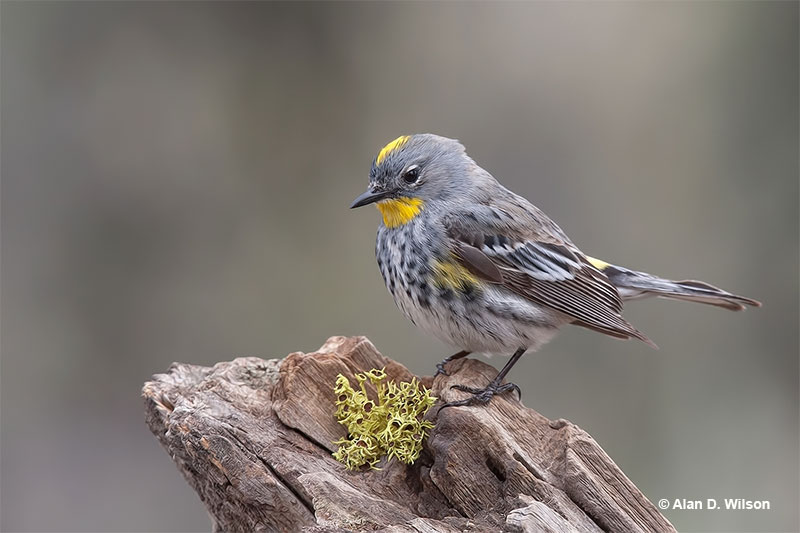The Yellow-rumped Warbler (Setophaga coronata) encompasses a group of four closely related subspecies.
They all share some identifying characteristics, such as a yellow rump and a yellow patch in front of each of their wings but look rather different otherwise. We will concentrate on the two that are found in North America, namely Audubon’s Warbler and Myrtle Warbler.
On this page
Identification
Yellow-rumped Warblers have black eyes, a small black bill, and a long, narrow tail. They’re small birds, although fairly large for a warbler, measuring 4.7-5.5 inches long with a wingspan of 7.5-9.1 inches.
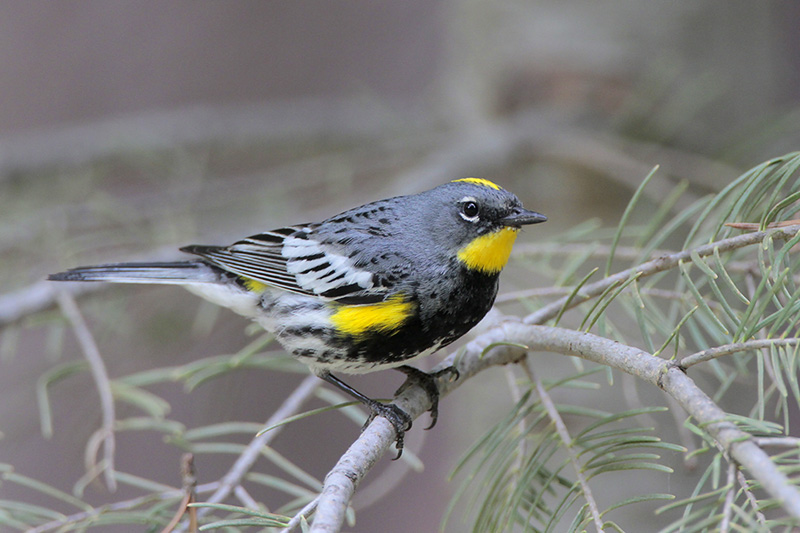
Audubon’s Warbler
During the summer season, both male and female Yellow-rumped Warblers have sleek gray plumage with flashes of white in their wings and yellow markings on their crown, rump, and sides.
The males stand out with striking and contrasting colors of gray, black, white, and yellow while the females appear duller and may display some brown tones. In winter, these birds become paler brown with the yellow rump and yellow sides remaining.
Distinguishing Audubon’s and Myrtle Warblers is rather easy.
When it comes to the breeding males, the Myrtle Warbler can be identified by its white eyebrows, white throat, black cheeks, and white sides of the neck. On the other hand, the Audubon’s Warbler lacks eyebrows, has a uniformly gray face, and flashes a yellow throat.
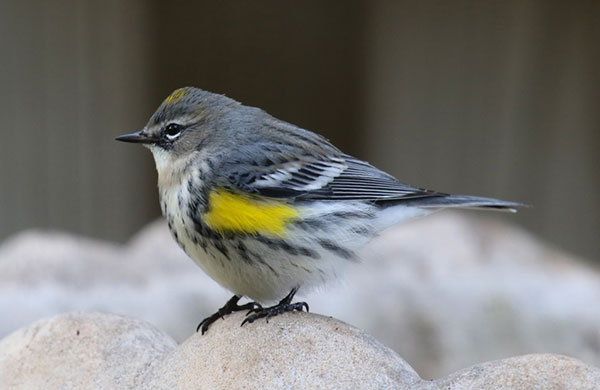
Myrtle Warbler
Females and non-breeding males of both subspecies follow a similar pattern but appear less vibrant compared to their breeding male counterparts.
Female Myrtle Warblers tend to have a browner upper plumage, while female Audubon’s Warblers lean towards a grayer tone. Immature Yellow-rumped Warblers maintain the basic plumage pattern of adults but appear much browner, paler, and duller.
Male Yellow-rumped Warblers sing a gentle melodious warble that lasts for 1-3 seconds and consists of 3-7 syllables that sound like tyew-tyew-tyew.
The pitch may slightly rise or fall. Their most common call is a sharp check but they may also emit soft psit sounds and a high-pitched tsee while in flight.
Food
Yellow-rumped Warbler’s diet consists of insects and berries. During the summer, they primarily feed on insects, such as caterpillars, beetles, ants, scale insects, aphids, and various other species.
They also consume spiders, grasshoppers, caddisflies, craneflies, and gnats. When insects are scarce, especially in the winter, they supplement their diet with fruits, berries, and seeds, including wax-myrtle berries, juniper berries, poison ivy, poison oak, greenbrier, grapes, Virginia creeper, dogwood, and seeds from beach grasses and goldenrod.
These warblers are versatile foragers. You can see them foraging on the ground, on tree trunks, clinging to twigs and branches, and hovering or flying out to catch insects.
During the breeding season, males tend to forage at higher levels than females. In winter, they often form foraging flocks. They often visit bird feeders, particularly for fruit and suet.
Nesting and Eggs
During the breeding season, the male Yellow-rumped Warblers closely follow the female, fluff their feathers, raise and flutter their wings, and call. This species forms monogamous pairs and breeds in mature mixed or coniferous woodlands.
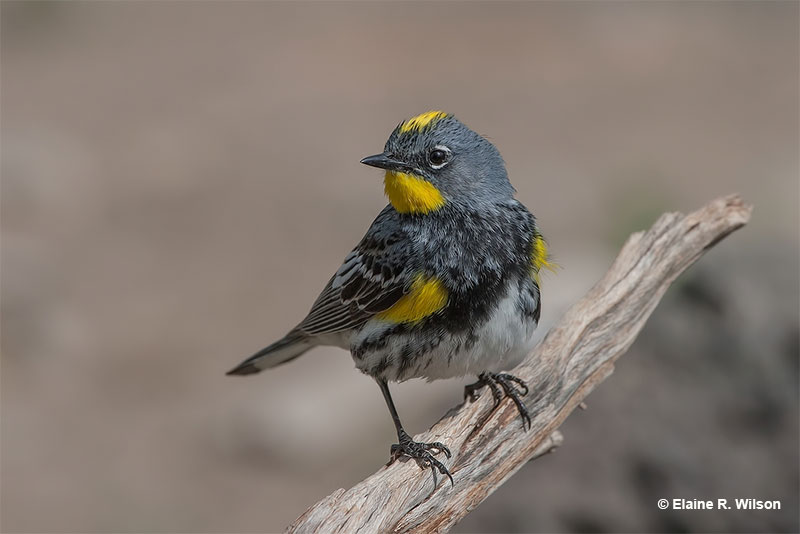
© Elaine R. Wilson
Yellow-rumped Warblers nest approximately 20 feet off the ground in coniferous trees such as spruce, pine, hemlock, and larch.
The nest placement can vary, either situated far out on a main branch or nestled securely in the fork between two or more branches. In some instances, they may even be found in deciduous trees like maple, oak, or birch.
The female builds the nest from bark fibers, weeds, twigs, and roots and lines it with hair and feathers. It is an open cup shape to arch over and partially cover the eggs. When completed, the nest measures around 3-4 inches in diameter and approximately 2 inches in height.
Yellow-rumped Warblers typically have 1-2 broods per year, with each clutch containing 1-6 eggs. The eggs are 0.7-0.8 inches long and 0.5-0.6 inches wide, creamy white, adorned with brown and gray markings.
Incubation lasts for 12-13 days and falls primarily on the female. Juvenile Yellow-rumped Warblers leave the nest after 10-12 days and are able to fly short distances within 2-3 days.
Current Situation
Yellow-rumped Warblers range throughout North and Central America.
The Myrtle Warbler’s range extends throughout the northern and eastern regions. It breeds across Canada and the northeastern United States, migrating to the southeastern United States, eastern Central America, and the Caribbean for the winter.
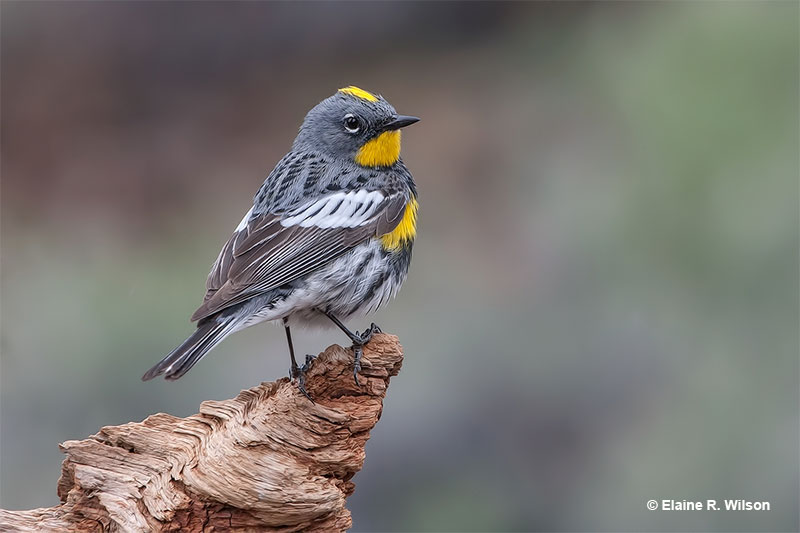
© Elaine R. Wilson
On the other hand, Audubon’s Warbler can be found on the western side. It breeds in western North America and winters in the southern portions of its breeding range and western Central America.
Since they’re migratory, then Yellow-rumped Warbler’s habitats change with the seasons. During the breeding season (or in North America), they reside in coniferous or mixed woodlands.
In the western United States, they tend to live in mountainous areas. During the non-breeding season, they migrate to more open areas with ample food, including agricultural and residential regions, secondary forests, shrublands, and similar habitats with relatively sparse vegetation.
The Yellow-rumped Warbler and its subspecies are listed as of least concern on the IUCN Red List. It is abundant throughout its range and its population remains stable.
Facts
- The proper classification of the Yellow-rumped Warbler’s forms remains up for clarification. It is generally agreed that Audubon’s, Myrtle, and Goldman’s Warblers are clearly separate whereas the classification of the Black-fronted Warbler is still debated. Audubon’s Warbler ranges throughout western North America, Myrtle Warbler ranges throughout the northern and eastern parts of North America, Goldman’s Warbler is resident throughout Mexico and Guatemala, and Black-fronted Warbler resides in northwestern Mexico.
- Yellow-rumped Warblers are the only warblers able to digest the wax in berry coatings on berries such as wax myrtle and bayberry. This allows them to winter farther north.
- Yellow-rumped Warblers are also called butterbutts because of their bright yellow rumps.
Similar Species
Yellow-rumped Warblers can be confused with Magnolia Warblers, Yellow-throated Warblers, and Townsend’s Warblers. Here you can read how to tell them apart.
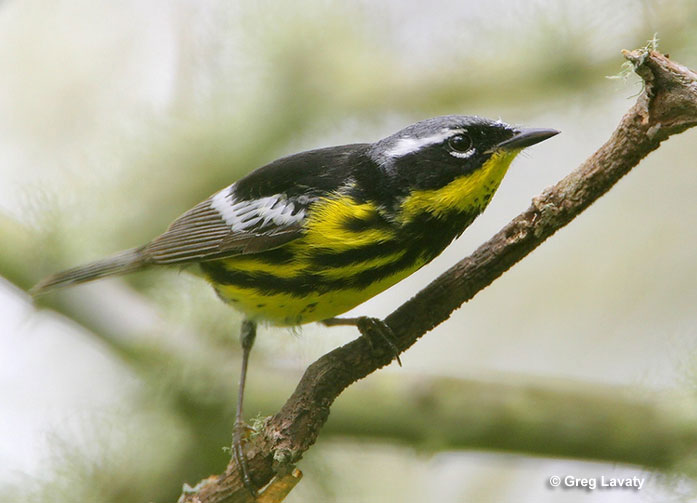
Magnolia Warbler
While Magnolia Warbler’s face pattern resembles Myrtle Warbler’s, they have a yellow instead of a white throat.
The two species have quite similar plumage, but Magnolia Warblers have a yellow belly instead of a pale one.
Male Magnolia Warblers also have a black patch on their back and no yellow crown.
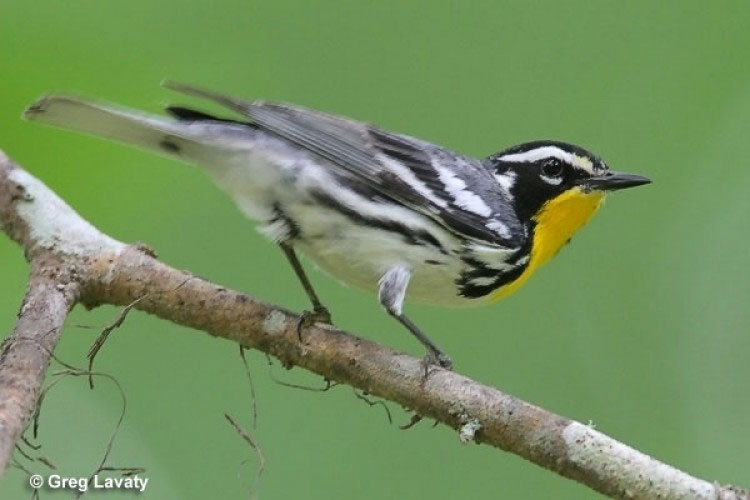
Yellow-throated Warbler
Face pattern is similar to the Myrtle Warbler’s face pattern, but the Yellow-throated Warbler has a yellow throat with the yellow extending to its upper breast.
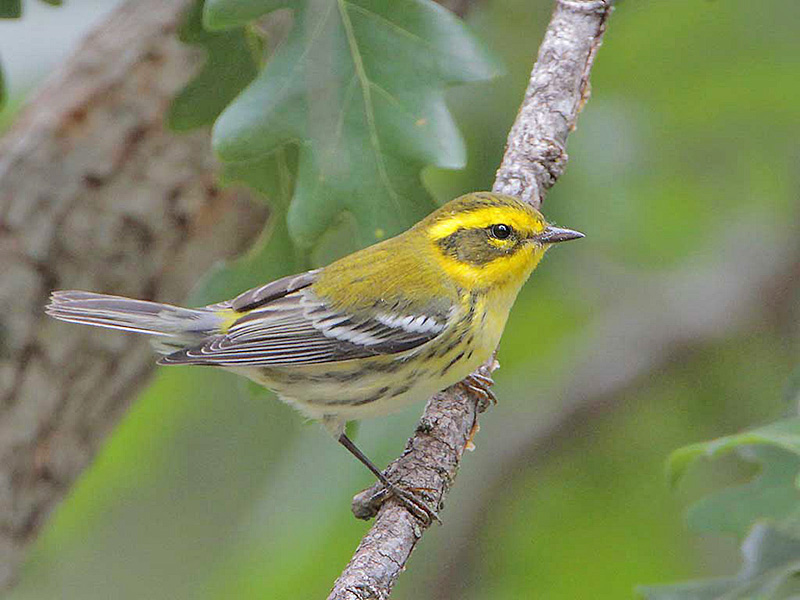
Townsend’s Warbler
Immatures and females may be confused with Yellow-rumped Warblers.
However, Townsend’s Warblers have more yellow on their head, the yellow on their throat extends further down to their breast.
They also have a yellow tinge.
Frequently Asked Questions
Are Yellow-rumped Warblers common?
Yellow-rumped Warblers are one of the most common birds in all of North America.
Do Yellow-rumped Warblers come to feeders?
Yellow-rumped Warblers visit bird feeders for seeds, fruit, and suet.
How big is a yellow-rumped warbler?
Yellow-rumped Warblers are small birds about 4.7-5.9 inches long.

